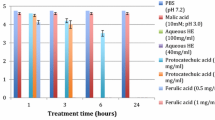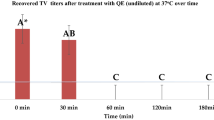Abstract
Aqueous Hibiscus sabdariffa extracts possess antimicrobial properties with limited information available on their antiviral effects. Aichi virus (AiV) is an emerging foodborne pathogen that causes gastroenteritis. Vaccines are currently unavailable to prevent their disease transmission. The objective of this study was to determine the antiviral effects of aqueous H. sabdariffa extracts against AiV. AiV at ~5 log PFU/ml was incubated with undiluted (200 mg/ml), 1:1 (100 mg/ml) or 1:5 (40 mg/ml) diluted aqueous hibiscus extract (pH 3.6), phosphate-buffered saline (pH 7.2 as control), or malic acid (pH 3.0, acid control) at 37 °C over 24 h. Treatments were stopped by serially diluting in cell-culture media containing fetal bovine serum and titers were determined using plaque assays on confluent Vero cells. Each treatment was replicated thrice and assayed in duplicate. AiV did not show any significant reduction with 1:1 (100 mg/ml) or 1:5 (40 mg/ml) diluted aqueous hibiscus extracts or malic acid after 0.5, 1, or 2 h at 37 °C. However, AiV titers were reduced to non-detectable levels after 24 h with all the three tested concentrations, while malic acid showed only 0.93 log PFU/ml reduction after 24 h. AiV was reduced by 0.5 and 0.9 log PFU/ml with undiluted extracts (200 mg/ml) after 2 and 6 h, respectively. AiV treated with 1:1 (100 mg/ml) and 1:5 (40 mg/ml) diluted extracts showed a minimal ~0.3 log PFU/ml reduction after 6 h. These extracts show promise to reduce AiV titers mainly through alteration of virus structure, though higher concentrations may have improved effects.


Similar content being viewed by others
References
Ali, B. H., Al Wabel, N., & Blunden, G. (2005). Phytochemical, pharmacological and toxicological aspects of Hibiscus sabdariffa L.: A review. [Review]. Phytotherapy Research, 19(5), 369–375. doi:10.1002/ptr.1628.
Blanton, L. H., Adams, S. M., Beard, R. S., Wei, G., Bulens, S. N., Widdowson, M. A., et al. (2006). Molecular and epidemiologic trends of caliciviruses associated with outbreaks of acute gastroenteritis in the United States, 2000–2004. Journal of Infectious Diseases, 193(3), 413–421. doi:10.1086/499315.
Borges, A., Ferreira, C., Saavedra, M. J., & Simoes, M. (2013). Antibacterial activity and mode of action of ferulic and gallic acids against pathogenic bacteria. [Research Support, Non-U.S. Gov’t]. Microbial Drug Resistance, 19(4), 256–265. doi:10.1089/mdr.2012.0244.
Chao, C. Y., & Yin, M. C. (2009). Antibacterial effects of roselle calyx extracts and protocatechuic acid in ground beef and apple juice. Foodborne Pathogens and Disease, 6(2), 201–206. doi:10.1089/fpd.2008.0187.
Chomnawang, M. T., Surassmo, S., Nukoolkarn, V. S., & Gritsanapan, W. (2005). Antimicrobial effects of Thai medicinal plants against acne-inducing bacteria. [Research Support, Non-U.S. Gov’t]. Journal of Ethnopharmacology, 101(1–3), 330–333. doi:10.1016/j.jep.2005.04.038.
Cowan, M. M. (1999). Plant products as antimicrobial agents. [Review]. Clinical Microbiology Reviews, 12(4), 564–582.
Cromeans, T., Park, G. W., Costantini, V., Lee, D., Wang, Q., Farkas, T., et al. (2014). Comprehensive comparison of cultivable norovirus surrogates in response to different inactivation and disinfection treatments. Applied and Environment Microbiology, 80(18), 5743–5751. doi:10.1128/AEM.01532-14.
Da-Costa-Rocha, I., Bonnlaender, B., Sievers, H., Pischel, I., & Heinrich, M. (2014). Hibiscus sabdariffa L.—A phytochemical and pharmacological review. Food Chemistry, 165, 424–443. doi:10.1016/j.foodchem.2014.05.002. Epub 2014 May 27.
Djeussi, D. E., Noumedem, J. A., Seukep, J. A., Fankam, A. G., Voukeng, I. K., Tankeo, S. B., et al. (2013). Antibacterial activities of selected edible plants extracts against multidrug-resistant Gram-negative bacteria. BMC Complementary and Alternative Medicine, 1013, 164. doi:10.1186/1472-6882-13-164.
Fino, V. R., & Kniel, K. E. (2008). UV light inactivation of hepatitis A virus, Aichi virus, and feline calicivirus on strawberries, green onions, and lettuce. Journal of Food Protection, 71, 908–913.
Fullerton, M., Khatiwada, J., Johnson, J. U., Davis, S., & Williams, L. L. (2011). Determination of antimicrobial activity of sorrel (Hibiscus sabdariffa) on Escherichia coli O157:H7 isolated from food, veterinary, and clinical samples. Journal of Medicinal Food, 14(9), 950–956. doi:10.1089/jmf.2010.0200. Epub 2011 May 6.
Goyer, M., Aho, L. S., Bour, J. B., Ambert-Balay, K., & Pothier, P. (2008). Seroprevalence distribution of Aichi virus among a French population in 2006–2007. Archives of Virology, 153, 1171–1174.
Hall, A. J., Wikswo, M. E., Pringle, K., Gould, L. H., Parashar, U. D., Division of Viral Diseases, N. C. f. I., et al. (2014). Vital signs: Foodborne norovirus outbreaks—United States, 2009–2012. MMWR. Morbidity and Mortality Weekly Report, 63(22), 491–495.
Higginbotham, K. L., Burris, K. P., Zivanovic, S., Davidson, P. M., & Stewart, C. N, Jr. (2014a). Antimicrobial activity of Hibiscus sabdariffa aqueous extracts against Escherichia coli O157:H7 and Staphylococcus aureus in a microbiological medium and milk of various fat concentrations. [Research Support, Non-U.S. Gov’t]. Journal of Food Protection, 77(2), 262–268. doi:10.4315/0362-028X.JFP-13-313.
Higginbotham, K. L., Burris, K. P., Zivanovic, S., Davidson, P. M., & Stewart, C. N, Jr. (2014b). Aqueous extracts of Hibiscus sabdariffa calyces as an antimicrobial rinse on hot dogs against Listeria monocytogenes and methicillin-resistant Staphylococcus aureus. Food Control, 40, 274–277. doi:10.1016/j.foodcont.2013.12.011.
Joshi, S. S., Dice, L., & H D’Souza, D. (2015). Aqueous extracts of Hibiscus sabdariffa decrease hepatitis A virus and human norovirus titers. Food and Environmental Virology. E-pub ahead of print.
Jung, E., Kim, Y., & Joo, N. (2013). Physicochemical properties and antimicrobial activity of Roselle (Hibiscus sabdariffa L.). Journal of the Science of Food and Agriculture, 293(15), 3769–3776. doi:10.1002/jsfa.6256.
Kakkar, S., & Bais, S. (2014). A review on protocatechuic Acid and its pharmacological potential. [Review]. ISRN Pharmacology, 2014, 952943, doi:10.1155/2014/952943.
Kingsley, D. H., Chen, H., & Hoover, D. G. (2004). Inactivation of selected picornaviruses by high hydrostatic pressure. Virus Research, 102, 221–224.
Le Guyader, F. S., Le Saux, J. C., Ambert-Balay, K., Krol, J., Serais, O., Parnaudeau, S., et al. (2008). Aichi virus, norovirus, astrovirus, enterovirus, and rotavirus involved in clinical cases from a French oyster-related gastroenteritis outbreak. Journal of Clinical Microbiology, 46(12), 4011–4017. doi:10.1128/JCM.01044-08.
Lin, H. H., Huang, H. P., Huang, C. C., Chen, J. H., & Wang, C. J. (2005). Hibiscus polyphenol-rich extract induces apoptosis in human gastric carcinoma cells via p53 phosphorylation and p38 MAPK/FasL cascade pathway. Molecular Carcinogenesis, 43(2), 86–99. doi:10.1002/mc.20103.
Liu, K. S., Tsao, S. M., & Yin, M. C. (2005). In vitro antibacterial activity of roselle calyx and protocatechuic acid. Phytotherapy Research, 19(11), 942–945. doi:10.1002/ptr.1760.
Lodder, W. J., Rutjes, S. A., Takumi, K., & de Roda Husman, A. M. (2013). Aichi virus in sewage and surface water, the Netherlands. Emerging Infectious Diseases, 19, 1222–1230.
McKay, D. L., Chen, C. Y., Saltzman, E., & Blumberg, J. B. (2010). Hibiscus sabdariffa L. tea (tisane) lowers blood pressure in prehypertensive and mildly hypertensive adults. [Randomized Controlled TrialResearch Support, Non-U.S. Gov’tResearch Support, U.S. Gov’t, Non-P.H.S.]. Journal of Nutrition, 140(2), 298–303. doi:10.3945/jn.109.115097.
Morton, J. (1987). Roselle. In Fruits of warm climates (pp. 281–286). Miami, FL.
Oh, E.-G., Kim, K.-L., Shin, S., Son, K.-T., Lee, H.-J., Kim, T., et al. (2013). Antiviral activity of green tea catechins against feline calicivirus as a surrogate for norovirus. Food Science and Biotechnology, 22(2), 593–598. doi:10.1007/s10068-013-0119-4.
Olaleye, M. (2007). Cytotoxicity and antibacterial activity of methanolic extract of Hibiscus sabdariffa. Journal of Medicinal Plants Research, 1, 9–13.
Ravishankar, S., Jaroni, D., Zhu, L., Olsen, C., McHugh, T., & Friedman, M. (2012). Inactivation of Listeria monocytogenes on ham and bologna using pectin-based apple, carrot, and hibiscus edible films containing carvacrol and cinnamaldehyde. [Research Support, Non-U.S. Gov’tResearch Support, U.S. Gov’t, Non-P.H.S.]. Journal of Food Science, 77(7), M377–M382. doi:10.1111/j.1750-3841.2012.02751.x.
Reuter, G., Boldizsar, A., Papp, G., & Pankovics, P. (2009). Detection of Aichi virus shedding in a child with enteric and extraintestinal symptoms in Hungary. Archives of Virology, 154, 1529–1532.
Reynolds, K. (2013). On tap: Aichi virus: Possible agent of unexplained cases of waterborne diarrhea. On Tap 55, 1, January 2013.
Ribes, J. M., Montava, R., Tellez-Castillo, C. J., Fernandez-Jimenez, M., & Buesa, J. (2010). Seroprevalence of Aichi virus in a Spanish population from 2007 to 2008. Clinical and Vaccine Immunology, 17, 545–549.
Saini, P., Gayen, P., Nayak, A., Kumar, D., Mukherjee, N., Pal, B. C., et al. (2012). Effect of ferulic acid from Hibiscus mutabilis on filarial parasite Setaria cervi: Molecular and biochemical approaches. [Research Support, Non-U.S. Gov’t]. Parasitology International, 61(4), 520–531. doi:10.1016/j.parint.2012.04.002.
Scallan, E., Hoekstra, R. M., Angulo, F. J., Tauxe, R. V., Widdowson, M. A., Roy, S. L., et al. (2011). Foodborne illness acquired in the United States—Major pathogens. Emerging Infectious Diseases, 17(1), 7–15. doi:10.3201/eid1701.091101p1.
Su, X., & D’Souza, D. H. (2011). Grape seed extract for control of human enteric viruses. Applied and Environment Microbiology, 77(12), 3982–3987. doi:10.1128/AEM.00193-11.
Su, X., & D’Souza, D. H. (2013). Grape seed extract for foodborne virus reduction on produce. Food Microbiology, 34(1), 1–6. doi:10.1016/j.fm.2012.10.006.
Su, X., Howell, A. B., & D’Souza, D. H. (2010a). Antiviral effects of cranberry juice and cranberry proanthocyanidins on foodborne viral surrogates—A time dependence study in vitro. Food Microbiology, 27(8), 985–991. doi:10.1016/j.fm.2010.05.027.
Su, X., Howell, A. B., & D’Souza, D. H. (2010b). The effect of cranberry juice and cranberry proanthocyanidins on the infectivity of human enteric viral surrogates. Food Microbiology, 27(4), 535–540. doi:10.1016/j.fm.2010.01.001.
Su, X., Sangster, M. Y., & D’Souza, D. H. (2011). Time-dependent effects of pomegranate juice and pomegranate polyphenols on foodborne viral reduction. Foodborne Pathogens and Disease, 8(11), 1177–1183. doi:10.1089/fpd.2011.0873. Epub 2011 Jul 21.
Sunday, O. A., Munir, A. B., Akeeb, O., Bolanle, A., & Badaru, S. O. (2010). Antiviral effect of Hibiscus sabdariffa and Celosia argen tea on measles virus. African Journal of Microbiology Research, 4(4), 293–296.
Švraka-Latifovic, Sanela. (2011). Thesis on: A systematic approach to elucidate causes of gastroenteritis outbreaks of suspected viral etiology. Tergooiziekenhuizen: RIVM, Erasmus University Rotterdam.
Tsai, P.-J., McIntosh, J., Pearce, P., Camden, B., & Jordan, B. R. (2002). Anthocyanin and antioxidant capacity in Roselle (Hibiscus sabdariffa L.) extract. Food Research International, 35(4), 351–356. doi:10.1016/S0963-9969(01)00129-6.
Yamashita, T., Adachi, H., Hirose, E., Nakamura, N., Ito, M., Yasui, Y., et al. (2014). Molecular detection and nucleotide sequence analysis of a new Aichi virus closely related to canine kobuvirus in sewage samples. Journal of Medical Microbiology, 63(5), 715–720. doi:10.1099/jmm.0.070987-0.
Yamashita, T., Ito, M., Tsuzuki, H., & Sakae, K. (2001). Identification of Aichi virus infection by measurement of immunoglobulin responses in an enzyme-linked immunosorbent assay. Journal of Clinical Microbiology, 39, 4178–4180.
Yamashita, T., Kobayashi, S., Sakae, K., Nakata, S., Chiba, S., Ishihara, Y., & Isomura, S. (1991). Isolation of cytopathic small round viruses with BS-C-1 cells from patients with gastroenteritis. Journal of Infectious Diseases, 164, 954–957.
Yamashita, T., Sakae, K., Kobayashi, S., Ishihara, Y., Miyake, T., Mubina, A., & Isomura, S. (1995). Isolation of cytopathic small round virus (Aichi virus) from Pakistani children and Japanese travelers from Southeast Asia. Microbiology and Immunology, 9(6), 433–435.
Yamashita, T., Sakae, K., Tsuzuki, H., Suzuki, Y., Ishikawa, N., Takeda, N., et al. (1998). Complete nucleotide sequence and genetic organization of Aichi virus, a distinct member of the Picornaviridae associated with acute gastroenteritis in humans. Journal of Virology, 72, 8408–8412.
Yang, Y. S., Wang, C. J., Huang, C. N., Chen, M. L., Chen, M. J., & Peng, C. H. (2013). Polyphenols of Hibiscus sabdariffa improved diabetic nephropathy via attenuating renal epithelial mesenchymal transition. [Research Support, Non-U.S. Gov’t]. Journal of Agriculture and Food Chemistry, 61(31), 7545–7551. doi:10.1021/jf4020735.
Yin, M. C., & Chao, C. Y. (2008). Anti-Campylobacter, anti-aerobic, and anti-oxidative effects of roselle calyx extract and protocatechuic acid in ground beef. International Journal of Food Microbiology, 127(1–2), 73–77. doi:10.1016/j.ijfoodmicro.2008.06.002.
Acknowledgments
The authors gratefully acknowledge the funding provided partly by the University of Tennessee-Institute of Agriculture (Multistate Project S1056). The authors also acknowledge Dr. Dunlap at UT-Advanced Microscopy Center for his assistance with the Transmission electron microscopy sample preparations and observations.
Author information
Authors and Affiliations
Corresponding author
Ethics declarations
Conflict of Interest
The authors declare that they have no conflict of interest.
Ethical Approval
This article does not contain any studies with human participants or animals that were performed by any of the authors.
Informed Consent
As this article does not contain any studies with human participants or animals performed by any of the authors, informed consent was not required.
Rights and permissions
About this article
Cite this article
D’Souza, D.H., Dice, L. & Davidson, P.M. Aqueous Extracts of Hibiscus sabdariffa Calyces to Control Aichi Virus. Food Environ Virol 8, 112–119 (2016). https://doi.org/10.1007/s12560-016-9229-5
Received:
Accepted:
Published:
Issue Date:
DOI: https://doi.org/10.1007/s12560-016-9229-5




